Related Research Articles

The Clovis culture is a prehistoric Paleoamerican culture, named for distinct stone tools found in close association with Pleistocene fauna at Blackwater Locality No. 1 near Clovis, New Mexico, in the 1920s and 1930s. It appears around 11,500–11,000 uncalibrated years before present (YBP) at the end of the last glacial period and is characterized by the manufacture of "Clovis points" and distinctive bone and ivory tools. Archaeologists' most precise determinations at present suggest this radiocarbon age is equal to roughly 13,200 to 12,900 calendar years ago.

Monte Verde is an archaeological site in southern Chile, located near Puerto Montt, Southern Chile, which has been dated to as early as 18,500 cal BP. Previously, the widely accepted date for early occupation at Monte Verde was about 14,500 years cal BP. This dating added to the evidence showing that the human settlement of the Americas pre-dates the Clovis culture by roughly 1,000 years. This contradicts the previously accepted "Clovis first" model which holds that settlement of the Americas began after 13,500 cal BP. The Monte Verde findings were initially dismissed by most of the scientific community, but the evidence then became more accepted in archaeological circles.

Meadowcroft Rockshelter is an archaeological site located near Avella in Jefferson Township, Washington County, Pennsylvania, United States. The site is a rock shelter in a bluff overlooking Cross Creek, and contains evidence that the area may have been continually inhabited for more than 19,000 years. If accurately dated, the site would be the earliest known evidence of human presence and the longest sequence of continuous human occupation in the New World.

The Aucilla River rises in Brooks County, Georgia, USA, close to Thomasville, and passes through the Big Bend region of Florida, emptying into the Gulf of Mexico at Apalachee Bay. Some early maps called it the Ocilla River. It is 89 miles (143 km) long and has a drainage basin of 747 square miles (1,930 km2). Tributaries include the Little Aucilla and Wacissa Rivers. In Florida, the Aucilla River forms the eastern border of Jefferson County, separating it from Madison County on the northern part, and from Taylor County to the south.
Apalachee Bay is a bay in the northeastern Gulf of Mexico occupying an indentation of the Florida coast to the west of where the Florida peninsula joins the United States mainland. It is bordered by Taylor, Jefferson, Wakulla, and Franklin counties.
Cactus Hill is an archaeological site in southeastern Virginia, United States, located on sand dunes above the Nottoway River about 45 miles south of Richmond. The site receives its name from the prickly pear cacti that can be found growing abundantly on-site in the sandy soil. Cactus Hill may be one of the oldest archaeological sites in the Americas. If proven to have been inhabited 16,000 to 20,000 years ago, it would provide supporting evidence for pre-Clovis occupation of the Americas. The site has yielded multiple levels of prehistoric inhabitance with two discrete levels of early Paleoindian activity.

The Big Eddy Site (23CE426) is an archaeological site located in Cedar County, Missouri, which was first excavated in 1997 and is now threatened due to erosion by the Sac River.

The Lindenmeier Site is a stratified multi-component archaeological site most famous for its Folsom component. The former Lindenmeier Ranch is in the Soapstone Prairie Natural Area, in northeastern Larimer County, Colorado, United States. The site contains the most extensive Folsom culture campsite yet found with a radiocarbon date of 10,600 to 10,720 B.P. Artifacts were also found from subsequent Archaic and Late pre-historic periods.

The Manis Mastodon site is a 2-acre (1 ha) archaeological site on the Olympic Peninsula near Sequim, Washington, United States, discovered in 1977. During the 1977-78 excavation, the remains of an American mastodon were recovered with a 13,800-year-old projectile point made of the bone from a different mastodon embedded in its rib. The site was placed on the National Register of Historic Places in 1978.
J&J Hunt Site (8JE740) is an inundated prehistoric archaeological site located 6 km off the coast of northwestern Florida. The site which was discovered in 1989 is located in 3.7 to 4.6 m of salt water in the Gulf of Mexico along the PaleoAucilla River. In prehistory the site had at least two different occupations: a Late Paleoindian-Early Archaic and Middle Archaic. The J&J Hunt site was a major focus of the PaleoAucilla Prehistory Project conducted by Michael K. Faught.
The indigenous peoples of Florida lived in what is now known as Florida for more than 12,000 years before the time of first contact with Europeans. However, the indigenous Floridians living east of the Apalachicola River had largely died out by the early 18th century. Some Apalachees migrated to Louisiana, where their descendants now live; some were taken to Cuba and Mexico by the Spanish in the 18th century, and a few may have been absorbed into the Seminole and Miccosukee tribes.
The Coats-Hines-Litchy site is a paleontological site located in Williamson County, Tennessee in the Southeastern United States. The site was formerly believed to be archaeological, and identified as one of only a very few locations in Eastern North America containing evidence of Paleoindian hunting of late Pleistocene proboscideans. Excavations at the site have yielded portions of four mastodon skeletons, including portions of one previously described as being in direct association with Paleoindian stone tools. The results of excavations have been published in Tennessee Conservationist, and the scholarly journals Current Research in the Pleistocene, Tennessee Archaeology, and Quaternary Science Reviews. The site was listed on the National Register of Historic Places on July 12, 2011.
Buttermilk Creek Complex refers to the remains of a paleolithic settlement along the shores of Buttermilk Creek in present-day Salado, Texas dated to approximately 15,500 years old. If confirmed, the site represents evidence of human settlement in the Americas that pre-dates the Clovis culture.
Saltville Archaeological Site SV-2 an apparent Pre-Clovis archaeological site located in the Saltville Valley near Saltville, Virginia. The site was excavated from 1992 to 1997 by paleogeographer Jerry N. McDonald of the Virginia Museum of Natural History.

The Prairie Creek Site is an archaeological site in the southwestern part of the U.S. state of Indiana. Located approximately 3 miles (4.8 km) north of Washington in Daviess County, it lies along the southern bank of the westward-flowing Prairie Creek, a White River tributary. About 1 mile (1.6 km) to the east of the site, the stream leaves the Thousand Acre Woods, a heavily wooded area around a glacial lake; six miles downstream is the creek's confluence with the White River.
The Suwannee point is a large unfluted lanceolate Paleo-Indians projectile point that features a recurvate profile with a slightly narrowed waist and a convex base. The point is one of the earliest forms of lanceolate types and is dated between 10500–9500 Before Present. It represents a typical example of the Middle Paleoindian subperiod. Experts are divided over whether the type predates or postdates the Clovis point but have noted that the two share similarities in their construction. Suwanee specimens are generally unfluted, which distinguishes them from the generally fluted Clovis. However, a few rare examples of fluted Suwanee have also been discovered. The largest concentration of Suwanee points appear in Florida, where the classification was first named in 1968 by Ripley P. Bullen for Suwannee County.
The Gulf Coastal Lowlands is a geomorphological province in Florida. The province extends along the coast of the Gulf of Mexico from the western end of the Florida Panhandle to near Ft. Myers in southern Florida. The average width of the province is 40 km. While much of the province is less than 15 m above mean sea level (msl), it rises to about 100 feet (30 m) above msl along its inland side. It is the largest geomorphological province in Florida. Due to its low elevation, the province was at sea level during warmer periods of the Pliocene and Pleistocene, and features such as ancient dunes and sand bars are found far inland. Marine terraces found in the Gulf Coastal Lowlands include the Silver Bluff [1 foot (0.30 m) to 10 feet (3.0 m) above mean sea level (msl)], Pamlico [8 feet (2.4 m) to 25 feet (7.6 m) above msl], Talbot [25 feet (7.6 m) to 42 feet (13 m) above msl], Penholoway [42 feet (13 m) to 72 feet (22 m) above msl] and Wicomico [70 feet (21 m) to 100 feet (30 m) above msl] terraces.
Michael Waters is a professor of Anthropology and Geography at Texas A&M University, where he holds the Endowed Chair in First American Studies. He specializes in geoarchaeology, and has applied this method to the investigation of Clovis and later Paleo-Indian, and possible pre-Clovis occupation sites.
The Anzick site (24PA506) in Park County, Montana, United States, is the only known Clovis burial site in the New World.
The Suwannee Valley culture is defined as a Late Woodland Southeast period archaeological culture in north Florida, dating from around 750 to European contact. The core area of the culture was found in an area roughly corresponding to present-day Suwannee and southern and central Columbia counties. It was preceded by the McKeithen Weeden Island culture and followed by the Spanish mission period Leon-Jefferson culture.
References
- Brown, Robin C. (1994). Florida's First People: 12,000 Years of Human History. Sarasota, Florida: Pineapple Press. ISBN 1-56164--032-8.
- Dunbar, James S. (2006). "Paleoindian Archaeology". In S. David Webb (ed.). First Floridians and Last Mastodons: the Page-Ladson Site in the Aucilla River. Dordrecht, The Netherlands: Springer. pp. 403–435. ISBN 978-1-4020-4325-3.
- Milanich, Jerald T. (1994). Archaeology of Precolumbian Florida. Gainesville, Florida: University Press of Florida. ISBN 0-8130-1273-2.
- Webb, S. David and James S. Dunbar (March 1998). "Page/Ladson site update". Aucilla River Times. XI (1). Retrieved 30 November 2011.
- Report of the 1999 Field Operations - PaleoAucilla Prehistory Project - accessed November 30, 2011
- Halligan, Jessi; Waters, Michael R.; Perrotti, Angelina; Owens, Ivy J.; Feinberg, Joshua M.; Bourne, Mark D.; Fenerty, Brendan; Winsborough, Barbara; Carlson, David`; Fisher, Daniel C.; Stafford, Thomas W.; Dunbar, James S. (2016). "Pre-Clovis occupation 14,550 years ago at the Page-Ladson site, Florida, and the peopling of the Americas". Science Advances. 2 (5): e1600375. doi:10.1126/sciadv.1600375. PMC 4928949 . PMID 27386553.
